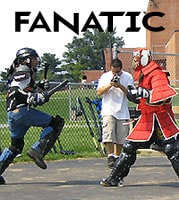Grappling is key if one is using a blade to stab a fellow inmate or remove a sentry, for control and the execution. However, in a dueling context, or even in a spontaneous situation where both fighters happen to have an edged weapon, the maneuver, present in every Hollywood film with a knife or sword duel, where the two antagonists press their weapons together, is a trope which permits conversation between characters and a moment of narrative tension.
In all of the 220-some machete duels I have been in only one involved a blade bind. In this statistically insignificant encounter, under the pavilion at Riverside Park in South Baltimore, Chuck Goetz and I were dueling with Ontario machetes, 16 inch blunts with hand guards made of bailing wire, when he chopped for my shoulder and I did a rising block and his blade notched mine, for a moment binding them, until I stopped resisting and slid my blade off of his and the ‘shank you’ dude dance continued.
With spring steel swords such an eventuality would be rarer still. Binds were classically the result of hilt design upgrades to rapiers and long swords [read two-handed swords] during periods when these weapons became tools employed in a dueling culture somewhat divorced from battle and spontaneous combat.
As soon as one party of a pair of antagonists who have bound swords commits to the tactile tension of the bind the other need only slide his blade free and cut his foe.
This question arose after a saber style stick sparring session. With sticks, a bind makes even less sense than with steel, as a dead hand stick can be grabbed by the opponent’s free hand as he slides his own stick free.
With knife length weapons binds are total fantasy. You can’t even block or parry a knife with a knife except by luck. It’s like hitting a bullet with a bullet.
The only bind training you should do with a blade is sliding out of a bind while grabbing your man’s wrist with your empty hand, and that is more likely to be practice rip-cutting free of his clothes or guts as you vacate his wheelhouse.
Brian Jewell's Latest Blog Post
link › jameslafond.blogspot.com
Being a Bad Man in a Worse World
Fighting Smart: Boxing, Agonistics & Survival











Duels aside - this is the only knife attack I recall seeing where the victim, stabbed, manages a leg sweep to take down his aggressor. It usually ends badly with the victim concentrating solely on trying to stop the sewing-machine arm.
youtube.com/watch?v=P3UKgN4gQdw
The only "grappling" technique I have found effective in knife dueling is using the lead hand as a parry or to grab the opponents weapon hand and stab with my rear hand. This is only moderately successful as it opens up your hand to get cut and also limits you mostly to a stab with your rear hand.
From the safe-space armchair, it seems that in a knife attack by a determined aggressor, once the anchoring left arm is attached to the victim, the game is almost up (repeated stabs of ever-increasing efficacy). Would it not be a priority to disable, or flick away, the reaching left arm and worry about the right, knife arm later, even at the cost of at least one stab? It might be too counterintutive, given the victim's fixation on the knife alone, but getting trapped and then trying to stop the rear, knife arm seems almost...ahem...pointless.
youtube.com/playlist?list=PL586FF51A65F9D84C
For the choice of magazine, I suggest Bob’s apparent favorite, “Architectural Digest”. With its stiff cover AD would definitely fit the bill. You could also roll a copy up tight in the manner that James suggests for a very effective yawara stick.
Great videos Bob! The first one in particular. Very illustrative. The knifer is clearly employing the Folsom Prison Method. It would appear that tactic/ technique has gone international, eh? It also appears, judging by the plethora of surveillance videos available to us via the Internet that the hold ‘em and hit ‘em ‘blitz’ attack is the most common form of ‘street’ assault these days. The attacker first gets close to the victim, distracts or diverts the victim’s attention in some manner and then, without warning, launches the surprise blitz attack. When he launches his assault in earnest the attacker holds the victim with one hand so he can’t escape and can’t maneuver and then punches or stabs him with the other hand. The attacker continues his punching or stabbing attack without respite until the victim collapses from his injuries and is unable to offer any resistance, and/or until the attacker has achieved the level of damage he may have heretofore decided to inflict on the victim (either put him in the hospital or the morgue). In most martial arts knife disarm routines the assumption is made that the attacker will lead with the knife and lunge at the defender like a foil fencer, overbalancing himself in the process, so that the defender can side-step the lunge and retaliate with all manner of spectacular and flashy disarming maneuvers. In my observation (and perhaps in all of yours as well) the martial arts just don’t address any defense against the hold and hit attack, at all. Even though it is so common now. What’s up with that? To survive any such surprise punching or stabbing attack you must do something to disrupt or defeat your opponent’s offensive capability. One way is by returning his blows and doing more damage to him than he is to you. That would be hard to do bare-handed against a knife, wouldn’t it? Another way would be to clinch and pin his punching/ knife arm (most people are just one-handed punchers anyway). Again it would be very hard to grab and hold with your hands alone onto a strong, fast-moving arm doing the sewing machine stich on your torso. However clinching with over-hooks or under-hooks is doable and would set the stage for you to execute a sweep or take-down of your assailant. Sweeping his attacker to the ground worked superbly for the victim in this instance. The attacker was much less effective in his stabbing attacks once he was placed in the supine position. It appeared the victim was able to pin the attacker’s knife arm then as well. Clearly the victim had some experience in Judo, Sambo or perhaps even some form of shin-kicking folk-style wresting that he was able to execute the sweep under such extreme duress. Notice that the knifer at one point, before being swept to the ground, used a hockey style stiff arm hold to keep the victim from striking back with his right hand and/or grabbing unto the attacker’s knife arm. This video also highlights the salient fact that knives lack stopping power. Note that the victim kept resisting, very effectively too as it turned out, even though it appeared he was stabbed in the abdomen at least a dozen times (it’s hard to gage how much his parka protected him). Imagine if the victim had had a knife as well, and he and the attacker held on to each other trading blows? Man, then it would be a horse race, eh? Although I think it’s safe to say that had that occurred the attacker would have released his hold on the victim and created some space so he could avoid being stabbed and cut in return. Lastly, because close range surprise knife attacks like this are so very difficult to defend against without becoming grievously injured, if you believe you are in particular danger of being the victim of one I would recommend wearing some kind of body armor under your clothing, including arm guards or vambraces. Even something as simple as a couple of thick magazines shoved in your waist band could make a world of difference.
@ Jeremy:
You're absolutely right about the disconnect between the martial arts and Folsom-prison, real world knife attacks, which need no special training and which use all deadly elements of confrontation: surprise, speed, bodyweight and repetition.
Unfortunately I have no insight into the lead-up to the assault in the Russian video I appended. It does appear somewhat of a "fight", with the knife as the only surprise. Mr. Snowy Parker appears to prepare by putting his drink down on the ground before squaring up to his antagonist, who could also have stabbed him as he was in an exposed, bent over position, but instead waited. Even though Mr. Bomber Jacket is forced back, he's still able to fire off several on-target stabs from a position of imperfect balance. Mr. Snowy Parker's collapse at the end of the clip doesn't augur well, despite his spirited defense. It's humbling lesson for grapplers. Snowy's punches to the Bomber's head seem ineffectual.
The video below shows the same primordial technique: secure with left hand and keep the blade well rear in the right. Even when falling to his knees and off-balance, the butcher only has to apply minimum force to inflict deadly wounds. Had the diner got up straight away when he sensed approaching danger and used a plate at head level, or a chair to keep the aggressor at bay, things might have gone down differently.
youtube.com/watch?v=4ti4x-pHv7g
I've taken to doing rotator cuff exercises in order to be able to put some power into an ax-hand where the elbow is confined to the chest and the arm rotates on a plane parallet to the body, a windshield wiper movement. This, because it's a very weak muscle set and so sets a power limit on certain angles of ax-hands. I want to be able to chop at very close range and at all angles, and hard enough to free myself from an unwanted grip.
Here's another grim one illustrating the danger of being held in weapon range by the reaper's left. Curling up and dodging is all too human, so I do sympathize. Still, a grab in a risky street context should trigger a reflex violent response, even where no weapon is seen.
youtube.com/watch?v=Yw-Apx06xrk
Applegate in his "Kill or Get Killed" talks about the profoundly psychologically shocking effect of even a small abdominal wound. Likewise, the kidney region of the back.
I recall an interview with Popeye Velásquez, Pablo Escobar's bodyguard and killer, in which he recounted how prison assassins often used rusty shanks, dipped in fecal matter before the task. A shanking survivor might still well die of septicemia.
Knife culture, another rich fruit of diversity.